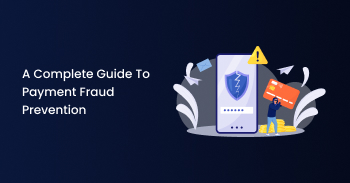By Shashank Survase
Principal Frontend Engineer
In 2024, businesses will be confronted with increasingly sophisticated digital fraud threats, exemplified by the utilization of deep fakes capable of replicating a user’s ID to gain illicit access to sensitive data. The consequences of fraud and identity theft pose significant business risks, encompassing substantial financial implications and reputational damage.
In this landscape, businesses must maintain heightened vigilance, stay abreast of potential fraud threats, adopt industry best practices, and integrate advanced identity verification solutions. Adhering to these procedures is essential for protecting customers and reducing the growing threat of digital identity fraud.
This blog examines common digital financial frauds like vishing, phishing, skimming, and website spoofing, outlining the tactics used by fraudsters. By understanding these threats, businesses can implement effective strategies to mitigate risks and safeguard themselves and their customers. It also explores technological advancements in digital banking fraud prevention, stressing the importance of staying ahead in the fight against fraud. From machine learning to real-time prevention, these tools are crucial for developing a strong defense against evolving fraudulent activities.
Types of digital financial frauds
Vishing: Phone call scam
Scammers use phone calls to extract sensitive information, posing risks of unauthorized access to corporate accounts and potential financial losses.
Phishing: Email scam
Deceptive emails target confidential banking information, leading to financial losses, legal consequences, and erosion of customer trust.
Spear phishing: Targeted email scam
Focused email attempts from trusted sources can result in data breaches, intellectual property theft, and the compromise of confidential business strategies.
SIM swap: Mobile number scam
Fraudsters conduct financial transactions using a new SIM card, leading to financial losses for companies if not promptly reported.
Smishing: SMS scam
Deceptive SMS messages can compromise confidential details, resulting in financial losses, business disruption, and reputational damage.
The increasing demand for comprehensive fraud prevention
In the ongoing battle against fraudulent activities, traditional prevention measures often prove inadequate in countering the constantly evolving tactics employed by fraudsters. The upsurge in fraud instances, including the widespread occurrence of SIM swap fraud, underscores the critical need for innovation. Relying on a single layer of defense is no longer sufficient. To effectively address the escalating risk of fraud, it is imperative to embrace a multi-layered approach. Implementing advanced strategies not only enhances the overall security posture but also provides a more robust defense against the ever-changing landscape of digital financial fraud.
Let’s have a quick analysis of the strategies and tools that assist in fraud mitigation and safeguarding business operations against evolving threats.
Comprehensive risk mitigation
Implementing a comprehensive risk mitigation strategy involves a holistic approach to identify, assess, and manage risks across all facets of digital financial transactions. By conducting thorough risk assessments and deploying preemptive measures, organizations can create a resilient defense against potential threats. This strategy encompasses a combination of technological solutions, employee training, and proactive risk management protocols to ensure a robust defense mechanism against evolving digital financial fraud.
For such risk mitigation, choose a service provider that provides a comprehensive set of capabilities, including thorough screening against sanctions lists, PEP, adverse media, and grey/black lists.
Real-time, cognitive, and automated preventive capabilities
Employing real-time, cognitive, and automated preventive capabilities signifies a forward-looking approach to fraud prevention. By integrating cognitive technologies and automation, financial institutions can swiftly adapt to emerging threats, analyze complex patterns in real-time, and proactively prevent fraudulent activities. This strategy enhances the efficiency of fraud prevention mechanisms, allowing organizations to stay one step ahead of cybercriminals through continuous learning and adaptive responses.
When choosing a service provider, consider factors such as research and development capabilities, the scalability of their solutions, and their commitment to staying ahead of the technological curve.
A dynamic solution for acquiring banks and merchants
A dynamic solution tailored for acquiring banks and merchants involves the implementation of adaptive tools and technologies specifically designed to address the unique challenges faced by these entities. By customizing fraud prevention measures based on the distinct risk profiles of acquiring banks and merchants, organizations can create a more targeted and effective defense against digital financial fraud. This strategy ensures that preventive measures align with the specific operational dynamics of acquiring banks and merchants, minimizing vulnerabilities in their digital ecosystems. With this strategy, businesses can ensure a robust and comprehensive approach to fraud prevention.
Real-time transaction monitoring
Real-time transaction monitoring is a proactive strategy that involves the continuous surveillance of financial transactions as they occur. By leveraging advanced technologies, organizations can monitor transactions in real-time, quickly identifying anomalies or suspicious activities. This approach enables immediate intervention, such as blocking or flagging potentially fraudulent transactions, thereby reducing the window of opportunity for malicious actors and enhancing overall fraud detection capabilities.
Real-time transaction monitoring can help financial businesses ensure minimal friction for legitimate transactions while providing maximum protection against fraudulent activities.
BANKiQ’s modern FRM approach to combating digital frauds
The contemporary payment value chain is intricate and extensive, marked by continuous data flow in both directions. This data is dynamic and in constant flux but is often confined within isolated structures. Traditional fraud analytics systems are constructed on record-based frameworks, primarily focused on scrutinizing extensive historical data to generate insights and predictions about fraudulent activities.
These conventional fraud analytics systems operate within isolated environments and are ill-equipped to keep pace with the diverse range of attacks on data and its sources. To effectively address this rapidly expanding threat landscape, payment providers must transition from the conventional, segmented approach to fraud detection to a more proactive, analytical strategy. The prevailing models are typically trained on historical data, fixed, and subsequently adjusted or weighted in periodic batches.
Why opt for BANKiQ IFRM?
- ScalabilityEffortlessly extends into new channels, geographies, and payment types. Our platform is designed to facilitate your expansion rather than impede it.
- FlexibilityConstruct models tailored to meet your distinct business requirements. Utilize the expertise of BankIQ IFRM and maximize the potential of your data.
- Real-TimeEvaluate events in mere milliseconds. Make well-informed decisions promptly, providing your customers with seamless experiences.
In the domain of digital financial security, BANKiQ discreetly emerges as a reliable partner, offering a seamlessly integrated fraud risk management strategy. Its specialized approach to acquiring banks and merchants is quietly acknowledged for its dynamic efficacy in addressing industry-specific challenges. BANKiQ’s discreet proficiency in real-time transaction monitoring, underlined by advanced analytics and anomaly detection, subtly positions it as a strategic ally for businesses seeking an unobtrusive yet powerful defense against digital financial fraud.
Conclusion
In the ongoing battle against fraud, staying well-informed about emerging trends is imperative—not merely as an option but as an absolute necessity. The landscape of financial crime trends is constantly in flux, requiring our unwavering vigilance and adaptability. A proactive approach to digital payment fraud prevention involves integrating risk assessment, detection methods, and robust security measures. This safeguards critical financial transactions and elevates the customer experience, reducing customer friction.
It is crucial to remember that fraud continually evolves, becoming more sophisticated and impactful with each passing day. This reality underscores the need for our relentless and continual efforts to combat fraud. As professionals in the financial services sector, we can collaboratively devise new and innovative strategies to mitigate fraud, ultimately fostering a safer environment for all.





